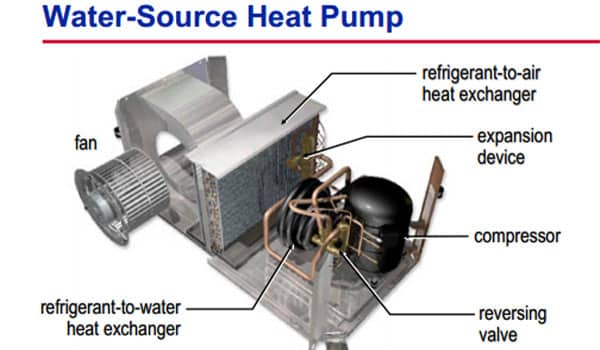Do you know when water source heat pumps were invented? In the 1940s, which is far later than heat pumps. However, after this invention, water source heat pumps have become very famous worldwide.

This heat pump is the right choice if you live near a water body. The most effective form of a heat pump is a water source unit.
It is around 4-5 percent more effective than a ground source unit, which may attain efficiencies of 400 percent. Anyone can use this heat pump for commercial or agricultural purposes easily.

A water source heat pump is a machine that takes energy from the water and converts it to heat, much like air source heat pumps. It produces heat when the water temperatures are lower than the needed air temperature in your home.
Do you know that your home's heating and hot water are provided by a water source heat pump (WSHP)? This machine harnesses the thermal energy of the water.
A perfect solution for homes near any sort of water body as it is the most effective way of converting heat from the water. The water temperature should be in the range of 60°F to 90°F [15.5° C to 32.2°C] so that the pump works properly. It works like an air source heat pump. However, instead of using air, WSHP uses water to extract heat.
During the research, we have found four types of water source heat pumps. Let’s get into the details.
When a suitable body of water is nearby, where the necessary plumbing can be run beneath the property, and into the water, a closed loop water source heat pump is the best option. A closed loop system is easy to install. While installing, it has fewer installation requirements.
Open loop systems need extra requirements during installation. This system needs enough clean water to run the system. It will pull and filter water from the primary water source.
Hybrid heat systems have a separate heating system for operation. These are best suited for old homes since they cannot be sufficiently protected to maximize the pump's effectiveness.
Solar-assisted pumps pair the water source heat pump with a solar thermal panel. Before physically jumping in, considering your options and speaking with the professionals is essential since picking the correct system is challenging.
However, in most cases, people mostly use closed loop systems and open loop systems. The closed-loop system of WSHP is more preferred when choosing between closed and open-loop systems.
As we know, WSHP needs to be installed near a water body, making heat transfer much easier. However, let’s learn about WSHP components, installation, control, and how it works.

Like other machines, a water source heat pump is made of components. Let’s know a little more about the components.
First, you must install the WSHP. Locate a spot inside your home where you feel is the best place for effective heat exchange. Install the pipes and connect them with a collector. These pipes need to reach the water body so the pipes can collect the heat from the water quickly.
These collectors need to be built outside the water. Collectors need to be floated out onto the surface and lowered to the bottom, where weights keep them in place. This keeps the pipes in a more compact shape, which may be practical if the water supply is limited.
The heat pump produces energy by moving the refrigerant through the collector and capturing the heat energy from the surrounding water. After passing via a compressor to boost the temperature to the desired level, the heat energy is then circulated to your heating and hot water distribution system (radiators, underfloor heating, hot water cylinder).
Install a control device that you can manage by using a smartphone or a display device mounted on a wall within your home or an internet browser. to control the WSHP. Talk to the technicians and ask for their assistance in training you on how to use them.
With the device’s controlling configuration, you can increase your efficiency even further by automatically adjusting your heat pump to match your preferred temperatures while also considering weather predictions.
Let us now explain the working process of WSHP. While installation, the pipes are placed underground. The underground pipes of the heat pumps do most of the temperature exchange. Using antifreeze liquid in closed-loop systems or the water from the source itself in open-loop systems, heat energy is efficiently transferred to the heat pump.
Let's know more about the details.
Whatever system your heat pumps have, heat will be transmitted from the water to a middle plate heat exchanger. Through an intermediary circuit, the energy is transferred to the heat pump's heat exchanger, or evaporator, where a refrigerant absorbs it.
When the refrigerant warms up, it transforms from a liquid to a gas. The refrigerant may absorb heat from shallow waters, which is a perfect heat absorber. This is why WSHP works best in cold climates.
The refrigerant is compressed to raise the temperature to a more usable level, and when it has changed into a gas, it is then fed to a heat exchanger. The condenser can release heat that will warm your water and radiators. When the gas begins to cool, it condenses and transforms back into a liquid. After that, it is sent back via an expansion valve to restart the process.
In other words, WSHP works by transferring the compressor to the interior unit. It also swaps the outdoor coil with a heat exchanger that uses the water in the building loop instead of outdoor air.
Finally, the entire process of WSHP working is the same as other heat pump methods once the heat energy has been introduced into the system.
Are you planning to buy and install a heat pump, the water-sourced one? So, you should know about the machine and installation costs.
The overall cost to install a water source heat pump in your house will often be close to $12000. While this may seem excessive, it's crucial to realize the financial advantages of installing a WHSP in your home. It saves around 15% of the annual bill.
Besides, installing the water-source heat pump in your home will last 15-50 years. WSHP lasts more than typical heat pumps.

We know that not all types of water sources can be used with a heat pump. To use these water sources effectively, you must thoroughly understand them. Let’s know the sources you can use with a heat pump here.
Now it’s time to answer the most important question as many types of heat pumps are available. Before WSHP, the first invented heat pump was air sourced. But when the WSHP was invented, it became trendy. However, one shouldn’t choose based on the popularity of WSHP.
Now it’s time to answer the most important question as many types of heat pumps are available. Before WSHP, the first invented heat pump was air sourced. But when the WSHP was invented, it became trendy. However, one shouldn’t choose based on the popularity of WSHP.
So why choose Water Source Heat Pumps (WSHP)?
Let’s know the answer.
The first reason is the lifespan of WSHP lasts from 15-50 years. After installing once, you will be tension free for a long time. Air source heat pumps don’t last long.
The following reason is that WSHP saves electricity bills annually by around 15%.which is a benefit too.
Do you know WHSP is combustion-free? The answer is a big yes. WSHP is combustion-free which conserves the environment as well.
Another reason for choosing WSHP is that WHSP is known as the most effective heating pump. Even if you use renewable electricity, the system is carbon-free.
We shouldn’t always think about ourselves. As a part of the environment, we should always think about the environment first. WSHP is also an environment-friendly heat pump.
To enjoy all the benefits and save this environment, one should choose Water Source Heat Pumps.
Finally, water source heat pumps are the most effective heat source producer. If you live near a water body, WSHP is the best choice.